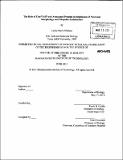| dc.contributor.advisor | Frank B. Gertler. | en_US |
| dc.contributor.author | Mebane, Leslie Marie | en_US |
| dc.contributor.other | Massachusetts Institute of Technology. Dept. of Biology. | en_US |
| dc.date.accessioned | 2011-08-18T19:14:33Z | |
| dc.date.available | 2011-08-18T19:14:33Z | |
| dc.date.copyright | 2011 | en_US |
| dc.date.issued | 2011 | en_US |
| dc.identifier.uri | http://hdl.handle.net/1721.1/65293 | |
| dc.description | Thesis (Ph. D.)--Massachusetts Institute of Technology, Dept. of Biology, 2011. | en_US |
| dc.description | Cataloged from PDF version of thesis. | en_US |
| dc.description | Includes bibliographical references. | en_US |
| dc.description.abstract | During central nervous system development cortical neurons extend a primary axon and multiple collateral branches to connect to numerous synaptic targets. While many guidance cues and their receptors have well-characterized roles in cortical axon guidance, the pathways that link these signals to cytoskeletal remodeling remain poorly understood. The Ena/VASP family of proteins function as key signaling molecules that influences actin reorganization in response to environmental cues, and has been implicated in many aspects of development. My work has focused on defining the mechanisms by which the brain-specific ubiquitin ligase, Trim9, regulates cytoskeletal dynamics in response to the axon guidance cue Netrin-1 and its receptor DCC. I have shown Trim9 binds the cytoplasmic tail of DCC and also binds Ena/VASP proteins and Myosin-X, which are cytoskeletal effectors downstream of Netrin-1. I discovered that inhibition of Trim9 ubiquitin ligase activity specifically blocks Netrin-1 induced cortical branching. I uncovered an interaction between Trim9 and the microtubule-associated protein, Map Ib, a regulator of microtubule stability and axon branching. My data demonstrates that Trim9 coordinates Netrin- 1 induced axon branching via its interaction with the cytoplasmic tail of DCC and cytoskeletal-associated proteins. I have also investigated the role of several actin-associated proteins in regulation of the actin ultra-structure. I used platinum replica electron microscopy to study the architecture of actin in neurons null for the Ena/VASP family, which failed to form axons. We determined the defect in axon formation is due to an inability to form bundled actin filaments and filopodia. In addition, splice isoforms Mena, a member of the Ena/VASP family, are tightly regulated during cancer metastasis and we determined these splicing changes influence the assembly of actin protrusions. My findings have helped to elucidate how environmental signals affect actin cytoskeletal dynamics and how changes in the cytoskeleton influence development. | en_US |
| dc.description.statementofresponsibility | by Leslie Marie Mebane. | en_US |
| dc.format.extent | 159 p. | en_US |
| dc.language.iso | eng | en_US |
| dc.publisher | Massachusetts Institute of Technology | en_US |
| dc.rights | M.I.T. theses are protected by
copyright. They may be viewed from this source for any purpose, but
reproduction or distribution in any format is prohibited without written
permission. See provided URL for inquiries about permission. | en_US |
| dc.rights.uri | http://dspace.mit.edu/handle/1721.1/7582 | en_US |
| dc.subject | Biology. | en_US |
| dc.title | The role of Ena/VASP and associated proteins in regulation of neuronal morphology and filopodia architecture | en_US |
| dc.type | Thesis | en_US |
| dc.description.degree | Ph.D. | en_US |
| dc.contributor.department | Massachusetts Institute of Technology. Department of Biology | |
| dc.identifier.oclc | 745033513 | en_US |
